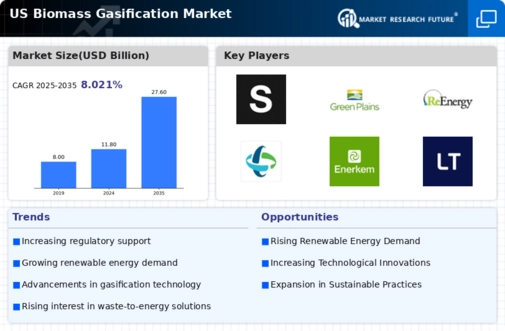Rising Energy Demand
The increasing energy demand in the US is a primary driver for the biomass gasification market. As the population grows and industrial activities expand, the need for sustainable energy sources intensifies. Biomass gasification offers a viable solution by converting organic materials into syngas, which can be used for electricity generation and heating. According to the US Energy Information Administration, renewable energy sources, including biomass, are projected to account for approximately 20% of total energy consumption by 2030. This shift towards renewable energy is likely to bolster the biomass gasification market, as stakeholders seek to diversify their energy portfolios and reduce reliance on fossil fuels.
Economic Incentives for Renewable Energy
Economic incentives play a crucial role in promoting the biomass gasification market. Various federal and state programs offer financial support for renewable energy projects, including biomass gasification. Tax credits, grants, and subsidies can significantly reduce the initial investment costs associated with biomass facilities. For instance, the Investment Tax Credit (ITC) allows for a 26% tax credit for renewable energy investments, which could encourage more stakeholders to enter the biomass gasification market. As these economic incentives continue to evolve, they may stimulate growth and innovation within the sector.
Environmental Sustainability Initiatives
The push for environmental sustainability is significantly influencing the biomass gasification market. With increasing awareness of climate change and its impacts, there is a growing emphasis on reducing greenhouse gas emissions. Biomass gasification presents an opportunity to convert waste materials into energy, thereby minimizing landfill use and lowering carbon footprints. The US government has set ambitious targets to reduce emissions by 50% by 2030, which may drive investments in biomass technologies. Furthermore, the Environmental Protection Agency has recognized biomass as a renewable energy source, potentially enhancing the market's appeal to investors and policymakers.
Growing Interest in Circular Economy Practices
The growing interest in circular economy practices is driving the biomass gasification market. This approach emphasizes the sustainable use of resources and waste reduction, aligning with the principles of biomass gasification. By converting organic waste into energy, biomass gasification supports the circular economy by closing the loop on resource use. The US is increasingly adopting circular economy strategies, with various initiatives aimed at promoting waste-to-energy technologies. This trend may lead to increased investments in biomass gasification facilities, as businesses and municipalities seek to implement sustainable waste management solutions.
Technological Innovations in Gasification Processes
Technological innovations are transforming the biomass gasification market by enhancing efficiency and reducing costs. Advances in gasification technologies, such as fluidized bed gasifiers and integrated gasification combined cycle systems, are improving the conversion rates of biomass to energy. These innovations not only increase the yield of syngas but also enable the use of a wider variety of feedstocks. As technology continues to evolve, it is expected that the biomass gasification market will become more competitive, attracting investments and fostering further research and development.

















Leave a Comment